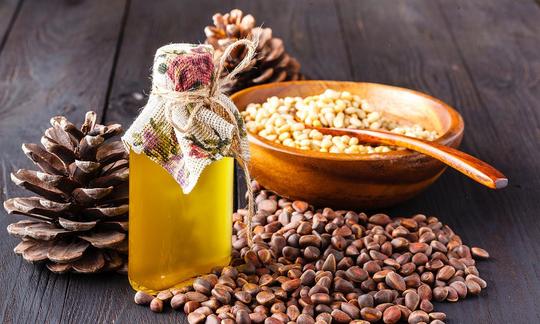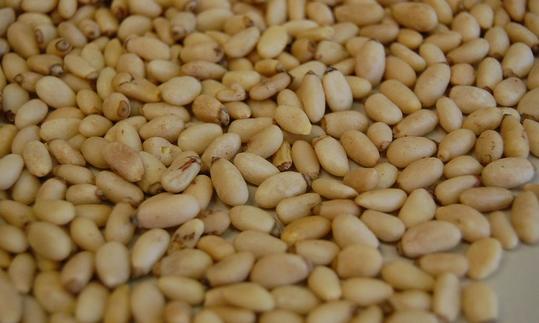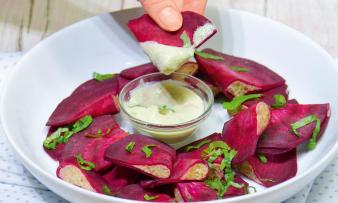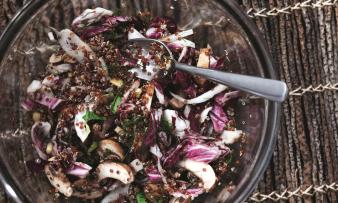Table of contents
Pine nuts are the tasty, mild seeds of certain pine species, including the stone pine ( Pinus pinea, also known as the Mediterranean pine). They are readily available in organic quality.
Using pine nuts in the kitchen:
The taste of raw pine nuts is not comparable to that of other nuts or seeds. They are very soft, have an almond-like sweetness and a slightly resinous aftertaste.
Pine nuts are good in sweet desserts, on biscuits (pignoli), but also in hearty sauces or salads. They go excellently with various vegetable dishes (e.g. avocado with tomato and banana filling and pine nuts, braised peppers with pine nuts and quinoa or spinach rice) or raw food creations.
Can you eat pine nuts raw or are raw pine nuts poisonous? You can eat pine nuts unroasted, as they are not poisonous when raw. As a vegan snack, you can eat them plain or add a little lemon juice. Many recipes use lightly roasted pine nuts because this gives them an intense nutty flavor. However, roasting creates trans fats that are harmful to health. We therefore recommend not roasting the nuts.
Pine nuts are often found in oriental and Mediterranean dishes. In Italy, they are particularly popular in soups and ragouts and are an important ingredient in 'Pesto Genovese'. Pine nuts can also easily be used to make vegan parmesan.
Pine nut oil is valued as an expensive gourmet oil on the market; however, rapeseed oil or linseed oil have a much healthier fatty acid composition. A by-product of the oil pressing process are pine nut flakes, which are used in muesli, chocolate or muesli bars. The flakes still contain up to 30% oil. If you press them further, you get flour. This can be used as a substitute for wheat flour in baked goods or pancakes.
Recipe for vegan parmesan:
Ingredients: a handful of pine nuts (organic), a handful of yeast flakes, 1 pinch of salt, organic spices to taste (e.g. oregano, chili powder, paprika powder, basil, pepper).
Preparation: Put the seeds in a blender and grind until they have the consistency of parmesan. Don't do it for too long, otherwise it will turn into a mush (porridge, puree). Then add the spices and yeast flakes. The vegan parmesan can be kept in a sealed box in the fridge for more than a week.
Vegan recipes with pine nuts can be found under the note: " Recipes that have the most of this ingredient ".
| Not only vegans or vegetarians should read this: Vegans often eat unhealthily. Avoidable nutritional errors. |
Shopping - where to buy pine nuts?
Peeled pine nuts can be found at major retailers such as Coop, Migros, Denner, Volg, Spar, Aldi, Lidl, Rewe, Billa, Edeka, Hofer, sometimes also in organic quality (bio). They are usually available all year round. The nuts can also be bought in organic shops, organic supermarkets (e.g. Alnatura or Denn's Biomarkt), Health food stores and online retailers. Pine nuts can be stored for much longer when unshelled, but they are rarely sold in retail stores 1 because they are relatively difficult to peel. Pine nuts are harvested from October to March, and are available in stores all year round. 1
With the common terms "raw" and "raw food", the trade mainly guarantees that the roasting process has been omitted. When drying the pine nuts (after harvesting), the producers do not always take the temperature restrictions seriously (e.g. 42 °C for "real" raw food). In addition, the term "raw food" is not legally protected - unlike organic. If raw food quality is important to you, you should consider trustworthy sources.
Why are pine nuts so expensive? Pine nuts are among the most expensive types of kernels and nuts in the world. Global production and therefore the supply of pine nuts is smaller than demand. In addition, harvesting and processing pine nuts is complex, 1 which is reflected in the price.
The availability of pine nuts in the supermarkets mentioned varies depending on the size of the store, catchment area, etc. If you are interested, click on our recorded food prices for the DA-CH countries (above under the ingredient image). There you will find current prices from various supermarkets and their price development.
Found in the wild:
Pine trees occur almost exclusively in the wild. There are only a few commercial plantations. More on this under "Cultivation-Harvest".
Storage:
Pine nuts are best stored in a cool, dark place in an airtight jar. They should be consumed quickly and not stored for too long to avoid rancidity.
Pine nuts: Ingredients - Nutritional values - Calories
Raw pine nuts are high in calories with 673 kcal/100g. Their fat content (68 g/100g) is striking. Of this, 4.9 g are saturated fatty acids. 100 g contain an average of 14 g of protein. Pine nuts are rather low in carbohydrates (13 g/100g) and fiber (3.7 g/100g). 2
Although pine nuts contain a lot of polyunsaturated fatty acids (PUFA: around 34% 2 or more 14), the ratio between omega-6 and omega-3 fatty acids is very unfavorable (approx. 210:1). Macadamia nuts (ratio of 6:1) and walnuts (ratio of 4:1) as well as linseed (1:4) have a much better LA:ALA ratio. 2
Among the essential nutrients, the high manganese content is notable. 100 g of pine nuts contain 8.8 mg of manganese : unshelled hemp seeds (7.6 g/100 g) and poppy seeds (6.7 g/100 g) have a similarly high content. With 575 mg/100 g, the kernels are also rich in phosphorus, similar to cashew nuts (593 mg/100 g).
Vitamin E is also plentiful, with 9.3 mg in 100 g. Hazelnuts (15 mg/100g), sunflower seeds (35 mg/100g) and almonds (26 mg/100g) provide more vitamin E. 2
Some ingredients are highly species-dependent. For example, the kernels of the Pinus koraiensis pine species, which is widespread in China, contain half as much protein as those of the stone pine ( Pinus pinea), but significantly more carbohydrates and fats. 13 The amount and composition of fatty acids are also subject to fluctuations. 2,8,14
The complete ingredients of pine nuts, the coverage of the daily requirement and comparison values with other ingredients can be found in our nutrient tables. In the article Nutrients explained you will get a detailed insight into the topic.
Dangers - Intolerances - Side effects:
In some cases, a bitter, metallic taste can remain after eating pine nuts. The taste irritation occurs either immediately or with a delay and usually subsides after two to four weeks at the latest. According to current scientific knowledge, there is no health risk. Residues of contaminants have been ruled out as the cause of the disorder. It is therefore assumed that a natural ingredient in the pine nuts causes the taste disorder. 3
The phenomenon is known as "pine nut syndrome" or "pine mouth". Most studies specify that the symptoms are caused by pine nuts of the species Pinus armandii. 1,13 Studies show that there may be a correlation between the genetic ability to perceive bitter tastes and the occurrence of taste irritation caused by pine nuts. It was shown that people affected by pine nut syndrome can also taste the bitter substance phenylthiocarbamide (PTC) very well. 4
Mold or aflatoxins can be a problem in nuts, dried fruit and pistachios from countries outside the EU - but also from Mediterranean countries. 15,16 According to the Federal Institute for Risk Assessment, however, all nuts and seeds in the EU are subject to appropriate controls and maximum levels, so there is no need to fear a specific risk for consumers. 15
Health aspects - effects:
How healthy are pine nuts? Due to the poor LA:ALA ratio, consuming them in large quantities is not recommended. As mentioned above (chapter "Ingredients"), linseed fares much better in this context: it has an extremely healthy ratio of 1:4, because it contains less potentially inflammatory LA (omega-6) and more anti-inflammatory omega-3 in the form of ALA. According to the Federal Office of Public Health ( FOPH), the value should not exceed 5:1 (LA:ALA) on average. Erb-Müesli, for example, can correct this. If you enter the option "sorting by health values" in the ingredients list, you can select healthy ingredients or those that compensate for a deficiency. The same applies to recipes, e.g. sorting by LA:ALA ratio. You can see the importance of this aspect in the link to olive oil, where we explain it in detail. 2
Pine nuts contain pinolenic acid (14% to 19% of the fatty acids present). Pinolenic acid has an anti-inflammatory effect. Studies on mice show that pinolenic acid has a positive effect on the immune system, as it seems to stimulate the production of lymphocytes. 8
Several studies have also shown that taking pine nut oil increases the concentration of certain satiety hormones in the blood, which leads to a reduction in appetite. 9,10
Occurrence - origin of pines:
The pine or Mediterranean pine ( Pinus pinea) belongs to the pine genus ( Pinus). Pines are the largest and most important conifer genus with more than 100 species that occur mainly in the northern hemisphere. Around 30 pine species in Asia, Europe, the Middle East and North America bear seeds that are edible for humans. 1,13
The main producers of pine nuts are China, North Korea, Russia, Pakistan and Afghanistan; in the Mediterranean region, the main producing countries are Italy, Turkey, Spain and Portugal. Global production of pine nuts fluctuates significantly, as pine trees produce a good harvest every 3-5 years. For the period 2014/15-2018/19, China was initially considered the main producing country. 1 Looking back at the 2019/2020 season 12, North Korea managed to narrowly top the list of producing countries on average over the five years, but China remains the main exporter. 12
Growing in the garden or as a potted plant:
Pine trees are not winter hardy, but can tolerate short-term frosts of -10 to -15 °C. Therefore, growing them in pots is preferable to growing them outdoors in the garden. The trees reproduce via seeds that are inside the pine cones. These are planted (cracked or peeled and placed) in a pot, covered lightly with soil and left to germinate in a warm (approx. 20 °C), shady place with sufficient moisture. After 2-4 weeks, a seedling will form. As soon as the seedling has formed, the plant should be placed in a bright place and watered regularly. Strong drafts or temperature fluctuations and vibrations will damage the plant. In summer, the tree needs a warm location (approx. 20 °C), while in winter it prefers a cool, bright place (approx. 10 °C). After 5 years, the plant is ready to be planted outside in a sunny spot that is sheltered from the wind. 6 However, you will have to wait much longer to harvest the pine nuts (see next chapter).
Cultivation - Harvest:
Pine nuts come almost exclusively from natural forests. They are rarely grown for nut production on a commercial plantation. This is because pine trees need between 10 and 40 years to bear nuts. Although there are no costs for cultivation, the labor costs are particularly high because collecting the cones and processing them is very labor-intensive. 1
Harvesting is done by hand or by special commercial vehicles. The cones are collected when they are still closed. Drying in the sun or in a drying machine heats up the cones and the scales open, causing the pine nuts to loosen and fall out of the cone. The pine nuts are separated from the cones by sieving. Before peeling, the pine nuts are soaked in water in the shell to increase elasticity and prevent the kernels from breaking. The kernels are peeled by mechanical friction or impact on a hard surface in special machines. The pine nuts are then dried and polished and separated according to size, integrity and color so that they can be packaged and sold. 1
Possibility of confusion:
The 'cedar kernels' offered in the trade are the kernels of the Siberian stone pine ( Pinus sibirica) - and not of the cedar ( Cedrus ; both are pine trees). The so-called 'cedar nuts' are rounder 5 and a little thicker than the nuts of the pine or Mediterranean pine ( Pinus pinea), which are known as pine nuts. You will find more information about this in the next chapter.
Other possible sources of confusion: There can be confusion between the Siberian stone pine ( Pinus sibirica) and the Swiss stone pine or Swiss stone pine / Swiss stone pine / Swiss stone pine ( Pinus cembra). Firstly, the two tree species look similar and secondly, the taxonomy of pines is a scientific point of discussion. 11 Some authors consider the Siberian stone pine to be a subspecies or variety of the Swiss stone pine ( Pinus cembra ssp./var. sibirica or even Pinus cembra sibirica). However, the Swiss stone pine or Swiss stone pine is not native to Siberia, but to the Alps and Carpathians. Their seeds are also edible, but the European 'cedar kernels' are not commercially used on a large scale. 12 However, the wood and the Swiss stone pine oil or Swiss stone pine oil produced from it are used. One rarely reads the spelling Zierbel(kiefer).
General information:
The term pine nuts refers to the edible seeds (kernels) of certain pine species (genus Pinus). They are obtained from pine cones. Only a small number of the pines that produce edible kernels for humans are commercially important. The kernels of Pinus koraiensis (Korean pine), Pinus sibirica (Siberian pine), Pinus pinea (stone pine) and Pinus gerardiana (Chilgoza pine) are among the most commonly consumed. 8,12
Because the different types of pine are difficult for laypeople to tell apart, 12 all kernels are generally listed under 'pine nuts' in the trade. Only the kernels of the Siberian stone pine ( Pinus sibirica) are sold in German-speaking countries as cedar nuts or cedar kernels. In English, you rarely read the specifications cedar kernels, cedar nut kernels or Siberian pine nut kernels.
Alternative names:
Pine nuts are known as Zirbelnüsse, Pignolen or Pignolien (Austrian), among others. The incorrect spelling is Pinien Kerne. In other languages they are called: pignolias, pine nuts, pine kernels (English); pinoli or pignoli (Italian); pignongs (French) and piñones (Spanish).
For Pinus gerardiana, which occurs in the Himalayan region (Pakistan, Afghanistan, India), the name "Gerard Pine" or "Chilgoza Pine" is common. 7
In common parlance, a distinction is rarely made between pine cones ( Pinus) and fir cones ( Abies), but they belong to different botanical plant genera.
Keywords for use:
The oil pressed from the kernels is used in the cosmetics industry as a massage oil and in soap production. 1
Literature - Sources:
Bibliography - 16 Sources
| 1. | INC International Nut and Dried Fruit Council. Pine nuts - Technical Information. 2019. [konsultiert über Wayback Machine, Nov. 2022] |
| 2. | USDA United Sates Department of Agriculture. |
| 3. | Bundesinstitut für Risikobewertung. Ursachen für den bitteren Geschmack von Pinienkernen bislang ungeklärt. 2011. |
| 4. | Risso DS, Howard L, VanWaes C, Drayna D. A potential trigger for pine mouth: a case of a homozygous phenylthiocarbamide taster. Nutr Res. Dezember 2015;35(12): 1122-1125. |
| 5. | Bundeszentrum für Ernährung. Zedernkerne. 2021. |
| 6. | Gartenjournal.net Pinie richtig pflegen und ihr mediterranes Flair geniessen. |
| 7. | American Conifer Society. Pinus Geriardiana / Chilgoza Pine. |
| 8. | Xie K, Miles EA, Calder PC. A review of the potential health benefits of pine nut oil and its characteristic fatty acid pinolenic acid. Journal of functional foods. 2016;23: 464-473. |
| 9. | Sørensen KV, Korfitzen SS, Kaspersen MH et al. Acute effects of delayed-release hydrolyzed pine nut oil on glucose tolerance, incretins, ghrelin and appetite in healthy humans. Clin Nutr. April 2021;40(4): 2169-2179. |
| 10. | Pasman WJ, Heimerikx J, Rubingh CM et al. The effect of Korean pine nut oil on in vitro CCK release, on appetite sensations and on gut hormones in post-menopausal overweight women. Lipids Health Dis. 2008 March 2008;20(7): 10. |
| 11. | Gernandt DS, López GG, García SO, Liston A. Phylogeny and classification of Pinus. Taxon. 2005;54(1):29-42. |
| 12. | INC International Nut and Dried Fruit Council. Nuts & Dried Fruits. Statistical Yearbook 2019 / 2020. Pine Nuts. S. 39-41. |
| 13. | Awan H, Pettenella D. Pine Nuts: A Review of Recent Sanitary Conditions and Market Development. Forests. 2017;8(10): 367ss. |
| 14. | ÖNWT Österreichische Nährwerttabelle. Pinienkerne ganz. |
| 15. | BfR Bundesinstitut für Risikobewertung. Aflatoxine. |
| 16. | Özay G, Ozer H. Mycotoxin problems in nuts and dried fruits from the Mediterranean basin. In: Leslie JF, Bandyopadhyay R, Visconti A. Mycotoxins: detection methods, management, public health and agricultural trade. 2008. |













Comments